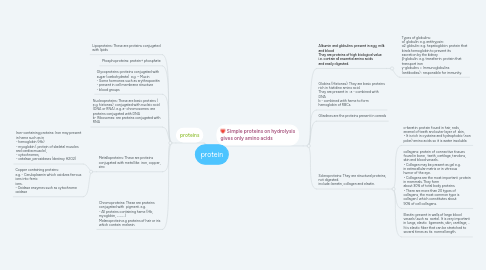
1. proteins
1.1. Lipoproteins: These are proteins conjugated with lipids
1.2. Phosphoproteins: protein+ phosphate
1.3. Glycoproteins: proteins conjugated with sugar (carbohydrate) e.g. – Mucin - Some hormones such as erythropoeitin - present in cell membrane structure - blood groups
1.4. Nucleoproteins: These are basic proteins ( e.g. histones) conjugated with nucleic acid (DNA or RNA). e.g. a- chromosomes: are proteins conjugated with DNA b- Ribosomes: are proteins conjugated with RNA
1.5. Metalloproteins: These are proteins conjugated with metal like iron, copper, zinc
1.5.1. Iron-containing proteins: Iron may present in heme such as in - hemoglobin (Hb) - myoglobin ( protein of skeletal muscles and cardiacmuscle), - cytochromes, - catalase, peroxidases (destroy H2O2)
1.5.2. Copper containing proteins: e.g. - Ceruloplasmin which oxidizes ferrous ions into ferric ions. - Oxidase enzymes such as cytochrome oxidase
1.6. Chromoproteins: These are proteins conjugated with pigment. e.g. - All proteins containing heme (Hb, myoglobin, ………..) Melanoprotein:e.g proteins of hair or iris which contain melanin.
2. Simple proteins on hydrolysis gives only amino acids
2.1. Albumin and globulins: present in egg, milk and blood They are proteins of high biological value i.e. contain all essential amino acids and easily digested.
2.1.1. Types of globulins: α1 globulin: e.g. antitrypsin: α2 globulin: e.g. hepatoglobin: protein that binds hemoglobin to prevent its excretion by the kidney β-globulin: e.g. transferrin: protein that transport iron γ-globulins = Immunoglobulins (antibodies) : responsible for immunity.
2.2. Globins (Histones): They are basic proteins rich in histidine amino acid. They are present in : a - combined with DNA b - combined with heme to form hemoglobin of RBCs.
2.3. Gliadines are the proteins present in cereals
2.4. Scleroproteins: They are structural proteins, not digested. include: keratin, collagen and elastin.
2.4.1. α-keratin: protein found in hair, nails, enamel of teeth and outer layer of skin. • It is rich in cysteine and hydrophobic (non polar) amino acids so it is water insoluble.
2.4.2. collagens: protein of connective tissues found in bone, teeth, cartilage, tendons, skin and blood vessels. • Collagen may be present as gel e.g. in extracellular matrix or in vitreous humor of the eye. • Collagens are the most important protein in mammals. They form about 30% of total body proteins. • There are more than 20 types of collagens, the most common type is collagen I which constitutes about 90% of cell collagens.
2.4.3. Elastin: present in walls of large blood vessels (such as aorta). It is very important in lungs, elastic ligaments, skin, cartilage, .. It is elastic fiber that can be stretched to several times as its normal length.
